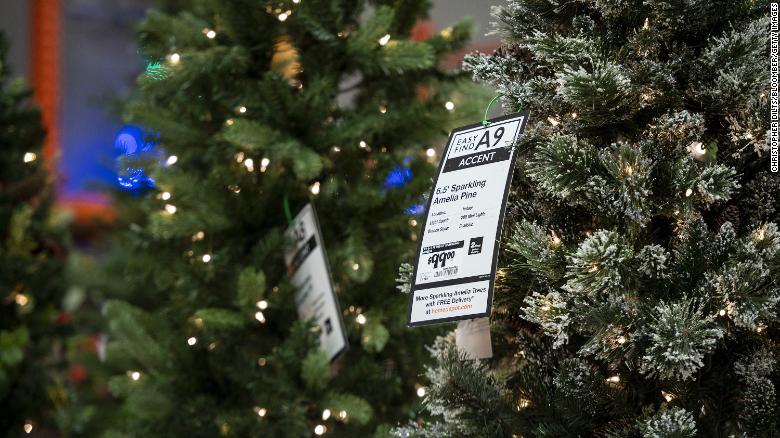You are here
Back to topNatural vs. artificial: The best Christmas tree option for the climate

Natural vs. artificial: The best Christmas tree option for the climate
It's the time of the year when most Americans finish Thanksgiving leftovers and venture out in search for the best holiday sales. More importantly, they plan their household centerpiece of the season: the Christmas tree.
While some revel in the scent of a real tree and the joy of picking one out at a local farm, others prefer the simplicity of artificial trees they can reuse for Christmases to come.
But consumers are becoming more climate-conscious, and considering which tree has the lowest impact on our rapidly warming planet has become a vital part of the holiday decision. Plus, choosing a planet-friendly tree will likely get you on Santa's good list.
So, which kind of tree has the lowest carbon footprint — a natural tree or a store-bought plastic tree? It's complicated, experts say.
"It's definitely a lot more nuanced and complex than you think," Andy Finton, the landscape conservation director and forest ecologist for the Nature Conservancy in Massachusetts, told CNN.
We've made a list — and checked it twice — of the things to know before you choose between real and artificial.
The case for artificial trees

It's easy to imagine that reusing an artificial tree year after year is the more sustainable option. But Finton says if an artificial tree is used for fewer than six years, the carbon cost is greater than investing in a natural tree.
"If the artificial trees are used for a longer lifespan, that balance changes," Finton told CNN. "And I've read that it would take 20 years for the carbon balance to be about equivalent."
That's because artificial trees are typically made of polyvinyl chloride plastic, or PVC. Plastic is petroleum-based and created at pollution-belching petrochemical facilities. Studies have also linked PVC plastic to cancer and other public health and environmental risks.
Then there's the transportation aspect. According to the US Department of Commerce, most artificial Christmas trees are imported into the US from China, meaning the products are carried by fossil fuel-powered ships across the Pacific Ocean, then moved by heavy freight trucks before it ultimately lands on the distributor's shelves or the consumer's doorstep.
The American Christmas Tree Association, a nonprofit that represents artificial tree manufacturers, commissioned WAP Sustainability Consulting for a study in 2018 that found the environmental impact of an artificial tree is better than a real tree if you use the fake tree for at least five years.
"Artificial trees were looked at [in the study] for factors such as manufacturing and overseas transportation," Jami Warner, executive director of ACTA, told CNN. "Planting, fertilizing and watering were taken into account for real trees, which have an approximate field cultivation period of seven to eight years."
What are the benefits of real trees?

Grounds crew load cut and packaged Christmas trees onto trucks at Noble Mountain Tree Farm in Salem, Oregon, in 2020. Noble Mountain is one of the largest Christmas tree farms in the world, harvesting about 500,000 trees per season.
On average, it takes seven years to fully grow a Christmas tree, according to the National Christmas Tree Association. And as it grows, it absorbs carbon dioxide from the air. Protecting forests and planting trees can help stave off the worst impacts of the climate crisis by removing the planet-warming gas from the atmosphere.
If trees are cut down or burned, they can release the carbon they've been storing back into the atmosphere. But Doug Hundley, spokesperson for the National Christmas Tree Association, which advocates for real trees, says the act of cutting down Christmas trees from a farm is balanced out when farmers immediately plant more seedlings to replace them.
"When we harvest the trees or cut them, we plant back very quickly," Hundley said.
If the idea of trekking through a forest to find the perfect tree is intriguing, you can buy a permit from the US Forest Service, which encourages people to cut their own tree rather than buy an artificial one. According to Recreation.gov, cutting down thin trees in dense areas can improve forest health.
But Finton doesn't recommend pulling a Clark Griswold and chopping down a massive tree to haul home — especially if it's in an area you're not permitted for. He recommends getting a tree from a local farm, instead.
"To me, the benefit of going to a Christmas tree farm, which is different than cutting a tree in the forest, is that it concentrates the impact of removing trees into one location," he said. "And it puts the responsibility on the farmers to regenerate those trees."
There's also an economic benefit to going natural, since most of the trees people end up getting are grown at nearby farms. About 15,000 farms grow Christmas trees in the US alone, employing over 100,000 people either full or part-time in the industry, according to the National Christmas Tree Association.
"What we're doing by purchasing a natural Christmas tree is supporting local economies, local communities, local farmers and to me, that's a key part of the conservation equation," Finton said. "When a tree grower can reap economic benefits from their land, they're less likely to sell it for development and less likely to convert it to other uses."
W/Cnn Environment







